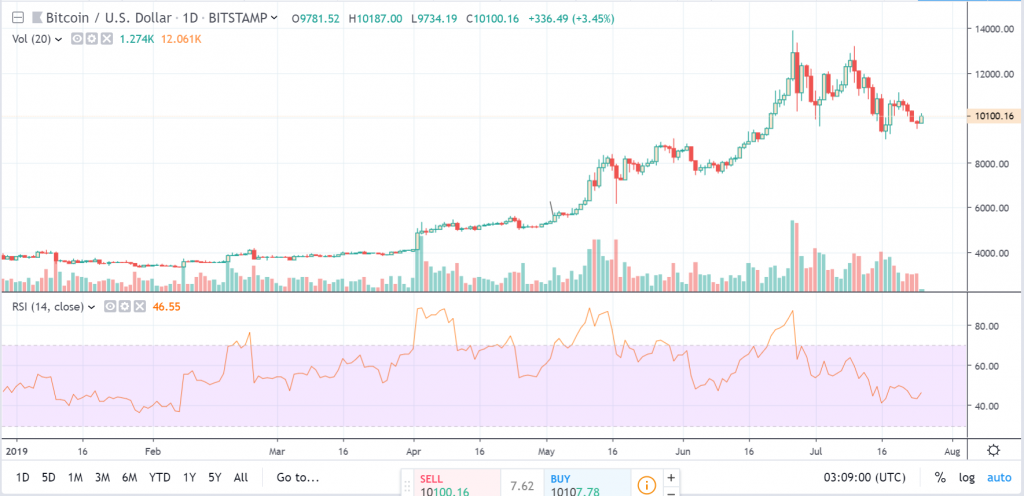Bitcoin just broke through $10,000, the third time this month, but it soon dipped below this psychological 5-digit barrier, which has turned formidable of late. As we noted in a previous article, the world’s favorite digital currency appears to be in consolidation mode, curiously forming its fifth stair step, since launching from $3,122 in late December. While analysts ponder potential next moves, there has been a preponderance of articles in the financial press warning investors that stock prices could tank this quarter. If so, then capital would flee at some point to find safe havens, possibly to both Gold and Bitcoin.
The high-altitude realms above $10,000 have been particularly difficult to traverse and hold for Bitcoin in both June and July. Its parabolic rise has been quite amazing, but rates of appreciation like these are seldom sustainable. The “struggle” is self-evident in the above chart, a rocky “double-top” rejection, followed by what you may recall from your Physics class, if you were paying attention, a damped harmonic oscillating curve.
This classic shape follows a burst of energy, which dissipates predictably as a sine-type wave, vibrating about a final equilibrium level, in this case, roughly $10,000. Surprisingly enough, the Relative Strength Indicator (RSI) shown at the bottom of the chart is a very popular “oscillating” indicator, developed with these same principles in mind. Analysts are presently bearish, regarding Bitcoin’s near-term prospects, but what gives them hope is the shape of the RSI curve. It has bounced off an oversold condition and broken through a diagonal drawn about its recent decline.
What must Bitcoin do to regain investor confidence and continue its drive upward? The consensus from a technical perspective is that it must close above $11,120, its most recent highpoint. Technical perspectives are one thing, but fundamentals are what drive price behavior. For months, analysts have cited over a dozen fundamental forces at work that have been propelling Bitcoin forward, perhaps, too quickly and in too short a time period, as noted by such “gurus” as Mati Greenspan, a senior analyst at eToro.
The recent “rocky road” has predominantly been a consequence of two weeks of vitriolic abuse heaped upon Facebook’s Project Libra by government officials and regulators across the globe. The critiques have been harsh, and by association, Bitcoin and its altcoin brethren have suffered. Steve Mnuchin, the U.S. Treasury Secretary, is one official that just keeps attacking. He had declared that cryptos were a “national security issue”, but on CNBC’s “SquawkBox“, he delivered another salvo: “I won’t be talking about Bitcoin in ten years, I can assure you that.”
Despite the negative press, Bitcoin has recovered, but the measure of its dominance in the crypto industry has declined over the past 10 days from 66.6% down to 64.6%, a signal that other token systems have gained ground in the process in the form of overall market share. Altcoin advocates are now hopeful that a highly anticipated rally in their sector, one that has refused to occur in recent months, will finally take place.
Hope may spring eternal among these riskier token “hodlers”, but previous “Alt Seasons” have taken place when investors were confident in the crypto space and looking for higher risk/reward dynamics than those offered by Bitcoin. The risk-tolerance “green light” may not be “on” just yet, and indications are that concerns over a potential global economic slowdown may keep cautionary “yellow lights” beaming for quite a while.
Early warning signals are beginning to emanate from several investment houses. JP Morgan Asset Management is just one of many. Jasslyn Yeo, global market strategist at the asset management giant, spoke on CNBC’s “Street Signs” and noted that: “In terms of timing, I think these two weeks will still be good for equity markets as we move into the Fed rate cut. We think there could be a risk that (earnings) would head downwards.” She was unable to suggest how deep a correction might occur, but she did say that the “sell-off would be driven by a downward revision in earnings forecasts for next year.”
Bitcoin enthusiasts have focused their attention upon the Bakkt exchange coming on stream, along with Fidelity Investments, TD Ameritrade, and e*Trade, as the major fundamental events on the near-term horizon, but a shift in global capital positions could spark another push north, as well.
The ongoing debate of which is the better “store of value asset”, Gold or Bitcoin, has been heating up of late. If “weak hands” begin to exit equity positions across the globe, the simple conclusion is that both Gold and Bitcoin will benefit handsomely for a period of time, until risk is fashionable again. Times could get very interesting and very soon.

